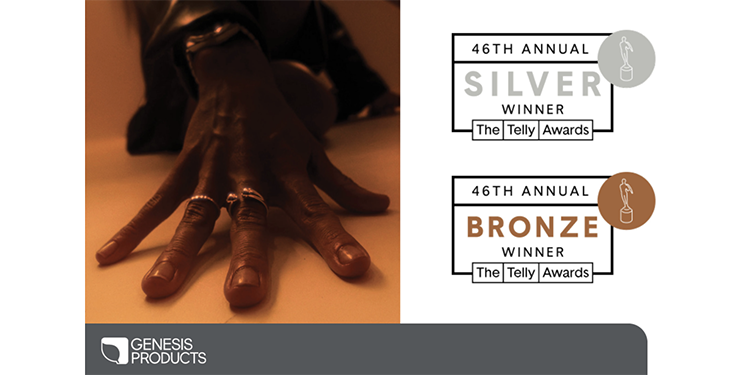National Bus Trader: Prevost Celebrates 100 Years (Part 1) – RVBusiness – Breaking RV Industry News
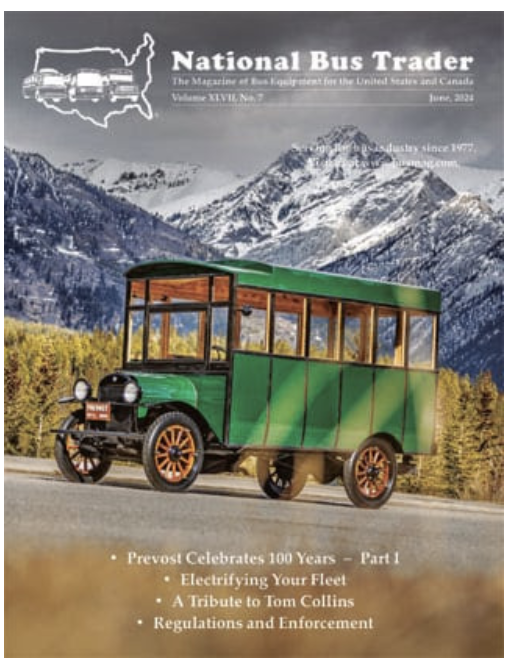
EDITOR’S NOTE: The following is an article written by Larry Plachno and published in the June 2024 issue of National Bus Trader magazine. It is reprinted here with permission. Because of the length of this article, NBT editors indicated they will present it in two parts. This first section covers from the founding of the company to adding the Volvo 9700 to the product line in 2009. The second and final part will cover from then to current activities. Click here to visit National Bus Trader magazine’s website.
Prevost celebrates a major anniversary in 2024, marking 100 years from the production of their first bus. Founded and still located in Ste-Claire, Quebec, Prevost came perilously close to closing its doors in the 1950s in the face of competition from the General Motors PD4104 and Scenicruiser. However, the company not only survived but also went on to become a major player in the production of intercity coaches for North America and today is part of the Volvo Group.
Ste-Claire is only about 23 aerial miles southeast of Quebec City and less than 50 miles from the border with Maine. A Frenchspeaking rural community with a population of a little more than 3,000, Ste-Claire is located on the Etchemin River in a hilly area.
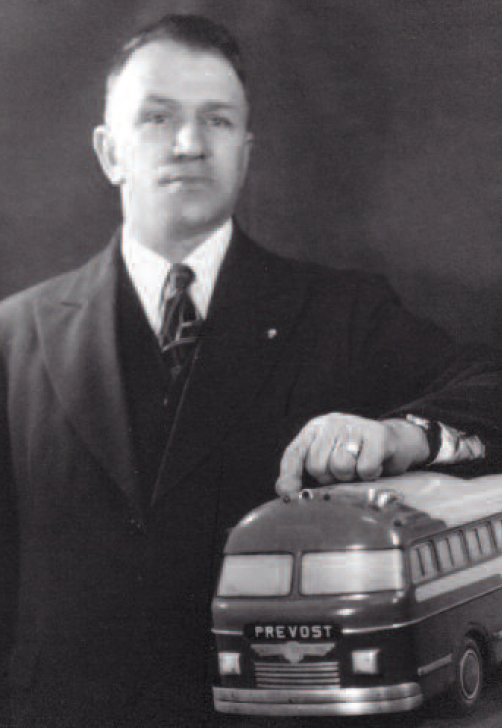
Some of the early Prevost facilities still exist in the town with the newer Boulevard Gagnon plant located on a hill overlooking the community. Prevost is the oldest and largest employer in the area.
The company is named after its founder, Eugène Prévost, who was born in 1899. In 1919, at the age of 20, Prévost went into the woodworking and furniture business and built a two-story building in Ste-Claire to house his operation. He originally became known for his specialty wooden furniture that included school desks, church pews and office furniture.
Looking back, Eugène Prévost’s involvement in buses happened by chance but would have a major impact on the future of the company.
In 1922, the late Georges Roy of Ste-Claire purchased the bus line of Guillermette et Dumas that operated a route from Quebec City to Levis, St. Henri and St. Anselme. Roy soon extended the route to Ste-Claire.
When he needed to expand his fleet in 1924, Roy purchased a Reo chassis and then approached Eugène Prévost to build a bus body on it. The resulting bus was built out of wood with aluminum sheeting. Roy was so pleased that he immediately ordered another and Prévost’s reputation as a bus builder spread. In those early years, the buses were built on the second floor of the furniture factory and were wheeled down a ramp at the rear when completed.
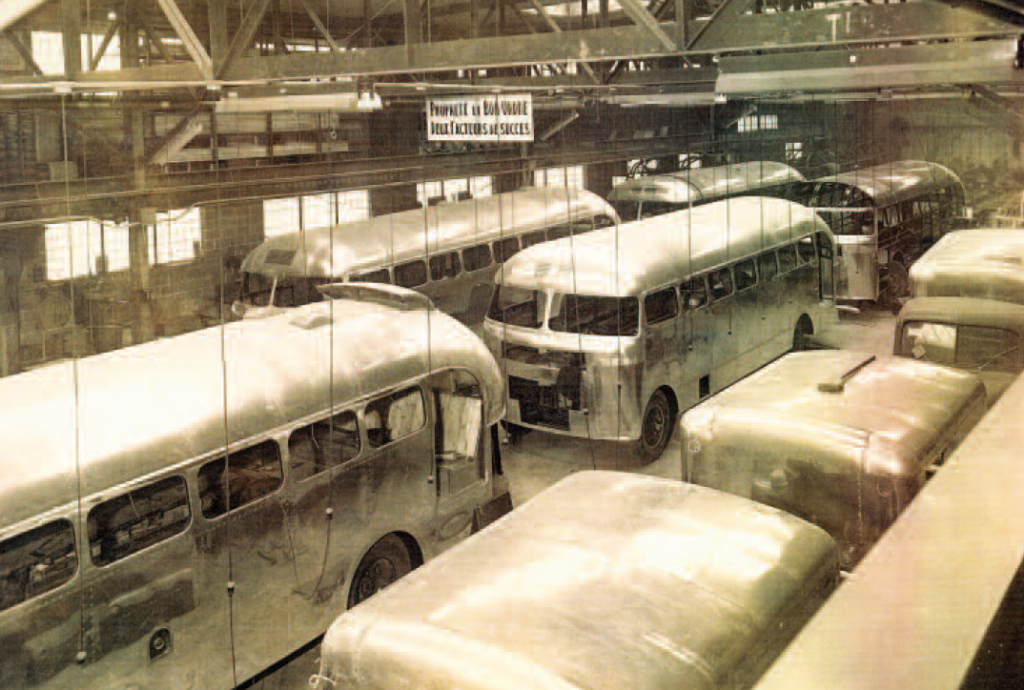
While wooden furniture continued as the most important business of the company, Prévost built approximately one bus a year until 1937. At that point bus production increased to as many as five or 10 buses annually.
The arrival of World War II, which came to Canada earlier than the United States, prompted additional orders including some buses for the Royal Canadian Air Force.
By the end of World War II, Prévost’s bus building operations had grown and become more sophisticated. The transition was made from wood to metal construction and the first all-metal, integral structure bus was built in 1945. Les Ateliers Prevost, Inc. was created in 1947 as a separate firm for manufacturing buses. At this same time Prevost began offering its new rear-engine Interurban model in four lengths. It looked much like a large clipper and introduced a lower window in the passenger door – something that would become popular with other manufacturers many years later.
In 1945, the growing business allowed Prevost to establish sales agents in Canada outside of Quebec, thus advancing the company from a provincial builder to sales throughout Canada. Prevost entered the transit market in 1949 with two models: the one for urban service and the Suburban for longer runs. They competed with the contemporary Canadian Car and Brill transits.
Prevost also built autos, small trucks, ambulances and similar vehicles. Prevost started the 1950s on a very positive note. Production exceeded 100 coaches in 1949, 1950 and 1952. The new Prevocar model was introduced in 1951. It was a luxury coach with double width windows, modern heating and ventilation systems, and an optional diesel engine. It was considered by many to be the most advanced coach built in Canada at that time and did a great deal to establish Prevost as an innovative builder willing to embrace new technology, an attribute that has remained with the company. Originally offered in 37- and 41-passenger capacities, a shorter 33-passenger model was added in 1953. Canadian National Defense ordered 100 Prevocars, probably the largest Prevost order at that time.
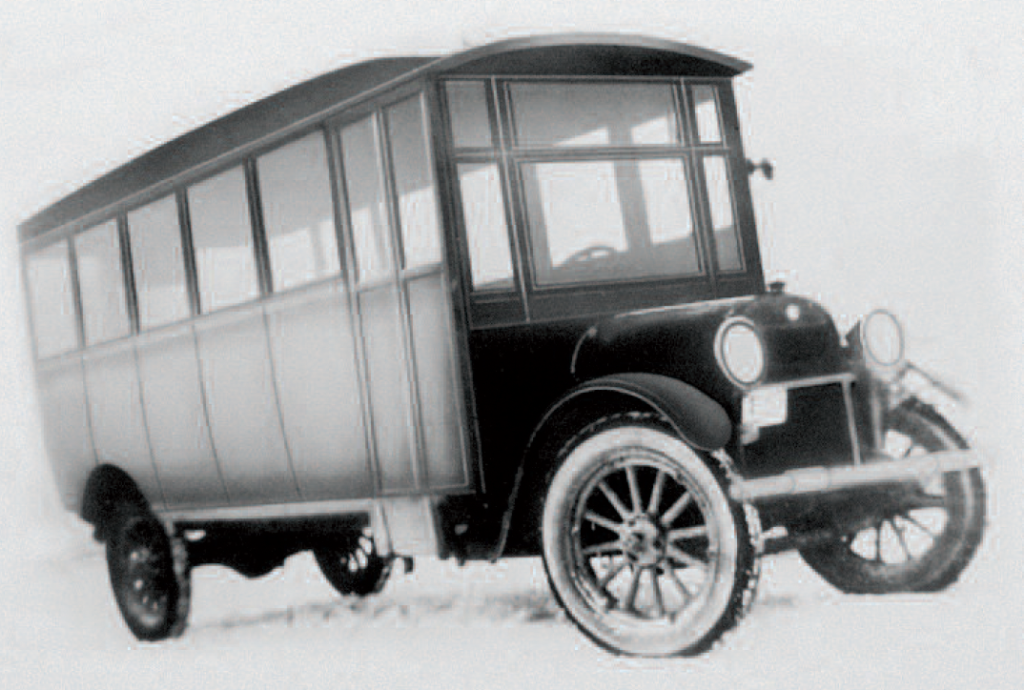
Because of these sales, Prevost became the largest builder of intercity coaches in Canada. In 1954, Prevost discontinued the last of its furniture business and concentrated on bus building.
The decade of the 1950s was deadly to most small bus manufacturers. General Motors was easily the largest bus builder in the United States by 1950. Because of their revolutionary PD4104 coach introduced in 1953 and the Scenicruiser the following year, the company ended up with 92 percent of the domestic market by 1960. GM also increased sales efforts in Canada. The U.S. Department of Justice filed an antitrust suit against GM in 1956, but it failed to help numerous small bus builders.
Aerocoach quit in 1952 and ACF-Brill quit a year later. Fitzjohn made its last bus in 1958. Mack acquired Beck in 1956 and quit in 1960. It did not help that Trailways was importing Eagles instead of buying local products. By the end of the decade, the only viable U.S. intercity coachbuilder remaining other than GM was Flxible. Prevost came perilously close to being another victim.
Following a very good year in 1952, Prevost built only 34 coaches in 1953, sales declined in 1954 and only two coaches were built in 1955. A new version of the Prevocar, called the Prevocar II, was introduced in 1954 but failed to stem the decline in sales. Prevost encountered financial difficulties in January of 1955 and sales did not improve in 1956 when only three buses were built. Most observers expected Prevost to shut their doors and join the other coachbuilders that had quit.
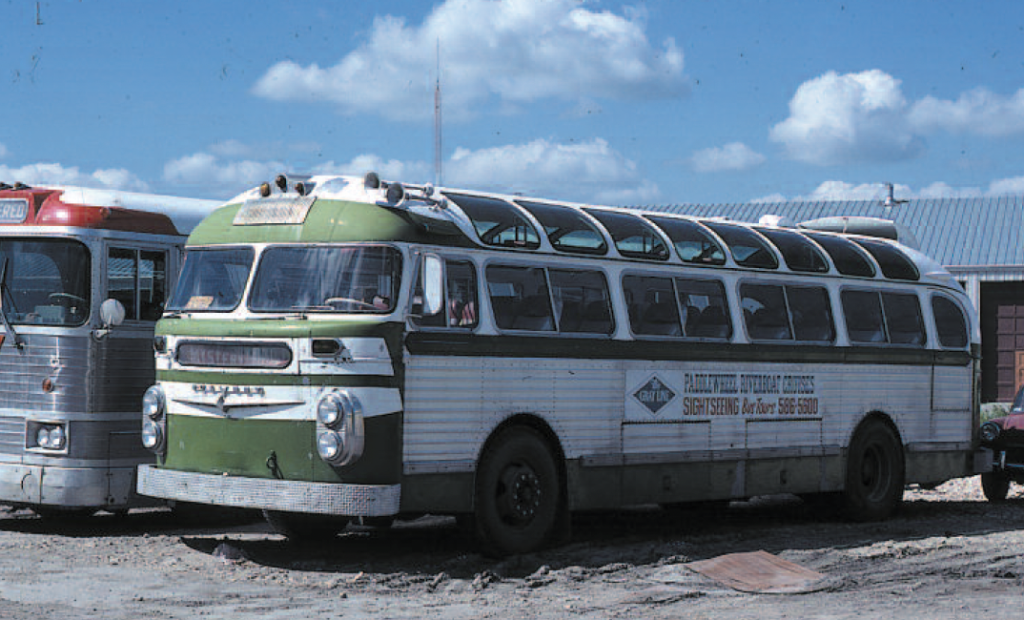
New Ownership Steps In
Salvation came in 1957 with the purchase and refinancing of the company by Paul Normand and Everiste Laflamme who already owned other industrial concerns. Now called Prevost Car, Paul Normand stepped in as company president replacing Eugène Prévost who had held that position since the founding of the company. What followed was an almost complete rebirth of the company. While only a skeleton staff remained in the production area, fortunately some engineering work had been completed on new models.
In 1957, Prevost introduced a new model known as the LeNormand named after the new majority owner of the company. It had silversides and was offered in several sizes with seating for 33, 37, 41 and 45 passengers.
While the LeNormand offered many of the features of contemporary coaches, it was different in having theater-type seating on a floor that sloped up towards the rear to provide improved passenger visibility.
Looking for additional sales, Prevost reentered the transit market in 1956 by offering a somewhat dated cab-over-engine Suburban model. This was followed in 1960 by a new model short bus known as the Travelaire that looked a little like the Flxible Flxette of later years. Newer models with more modern styling and rear engines were offered starting in 1961. However, only 80 transits of various models were produced between 1961 and 1967. As a result, Prevost left the transit market to concentrate on intercity coaches – a move that would prove successful in following years.
In 1962, the new Panoramique model with “new look” windows and new styling replaced the LeNormand and spun off a sister model known as the Observatoire. A total of 62 were built from 1962 to 1967, making the Prevost brand increasingly popular. One of the last built was a three-axle, 40-foot Panoramique for Autobus Deshaires that effectively became the first 40-foot coach built for an operator other than Greyhound and Trailways.
Unfortunately, Eugène Prévost passed away on February 2, 1965, just prior to a major move forward.
New TS-47 Models

Prevost led the movement to 40-foot coaches for the general coach industry by introducing their 40-foot Super Panoramique in 1966 – beating the MC-7 and PD4903 by two years. This became the start of what Prevost called their TS-47 models with a length of 40 feet and a width of 96 inches. The Super Panoramique was renamed the Champion and entered production in 1967. It is noteworthy that Somerset Bus Company in New Jersey purchased four Champions on July 5, 1968, bringing Prevost into the U.S. market.
A major change in ownership came in December of 1969. Tom Harbison, Bill Campbell and Andre Normand acquired the company from Andre’s father and Paul Gourdeau, who had purchased the Laflamme stock in 1966. Andre Normand took over as president of Prevost in 1969, becoming the third president since the company built its first bus. He is credited with improving the TS-47 product line and expanding the company.

Both Harbison and Campbell were members of the Family Motor Coach Association (FMCA). Harbison was a Bluebird dealer and was also involved with the National Motorhome vehicle. This influenced Prevost to build conversion shells in the following years. The first Champion conversion shell was built in 1970.
Murray Hill requested a unique model for their sightseeing business so the Prevost engineers took the basic TS-47 concept and replaced the “new look” windows with GM windshields mounted on end, providing huge passenger windows that curved into the roof. This gave the coach a European look although it retained a similar front end to the Champion. Originally delivered in 1968, this model was called the Panorama and was initially exclusive for Murray Hill. It was renamed the Prestige in 1973 after it became available to other U.S. and Canadian operators.
Prevost engineers next moved in the obvious direction and took the Prestige model, retained the tall side windows but moved from nine windows to 10, then restyled the front end with a matching tall windshield and a flat roof. Called the LeMirage, this new model was introduced in 1976 and put into production in 1977. It was an immediate success for tour and higher-class charter service and soon became Prevost’s most popular model.
Some would argue that while this model has gone through many changes and upgrades over the years, it has morphed into Prevost’s X3-45 model today.
While earlier Prevost coaches had been offered as motor home shells, it was the LeMirage that pushed Prevost into the big time. Both a 35-foot and a 40-foot shell were displayed at the Family Motor Coach Association’s 18th convention in Sioux Falls in the summer of 1978. Orders poured in and by February of 1980, Prevost private coach owners officially chartered the Prevost Proud Chapter of the Family Motor Coach Association.
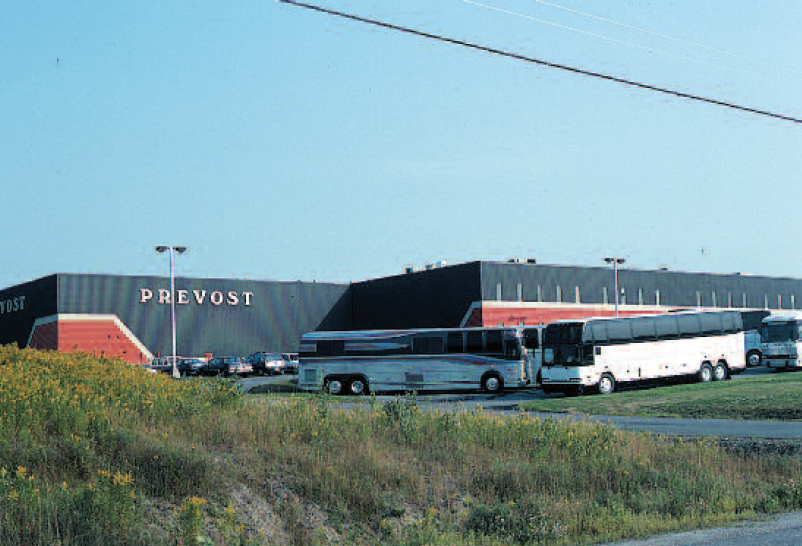
It soon became obvious that Prevost production was failing to keep up with orders because some of the facilities in Ste-Claire were cramped and portions were more than 50 years old. On May 30, 1981, Prevost held a formal opening ceremony at the new Boulevard Gagnon Coach Manufacturing Plant located on a hill overlooking Ste-Claire on a 2,000,000-square-foot site. The original plant had 90,000 square feet under roof and doubled Prevost’s production. The most unique feature of the new plant is that instead of a straight-through assembly line, it was built around “transporters,” which are similar to railroad transfer tables. This allowed the commercial coaches and conversion coach shells to bypass unneeded assembly stations that would not be possible with a conventional straight assembly line.
The Champion model was redesigned and emerged in March of 1983 as the Marathon model, essentially a “bread-and-butter” version of the TS-47 family for scheduled service. Prevost moved to the new 102-inch width in 1984 and the LeMirage became known as the XL. A sightseeing version with roof sightseeing windows, known as the Astral, was offered in 1985 as a distinct model. In later years a similar arrangement was offered as an option on the standard model.
The “H” Series

Prevost’s impressive H series of coaches can be traced back to a study by the Canadian and Quebec governments in the late 1970s. The Montreal-Ottawa-Toronto triangle corridor has the heaviest intercity traffic in all of Canada. A high-level Neoplan articulated coach was imported and equipped with testing and sensing devices. It was operated both empty and with equivalent passenger weight in these corridors to see whether articulated coaches could be used in harsh Canadian winters.
Prevost was selected to build the coach resulting from these tests that also included new technology and systems. The resulting Prevost H5-60 prototype emerged in late 1985. It was 60 feet long, seated 72 passengers, had five axles with single tires and was powered by an underfloor 8V-92TA engine in the front section. Regular production started in 1987 and continued for a few years. It became the only production articulated coach model built in North America.
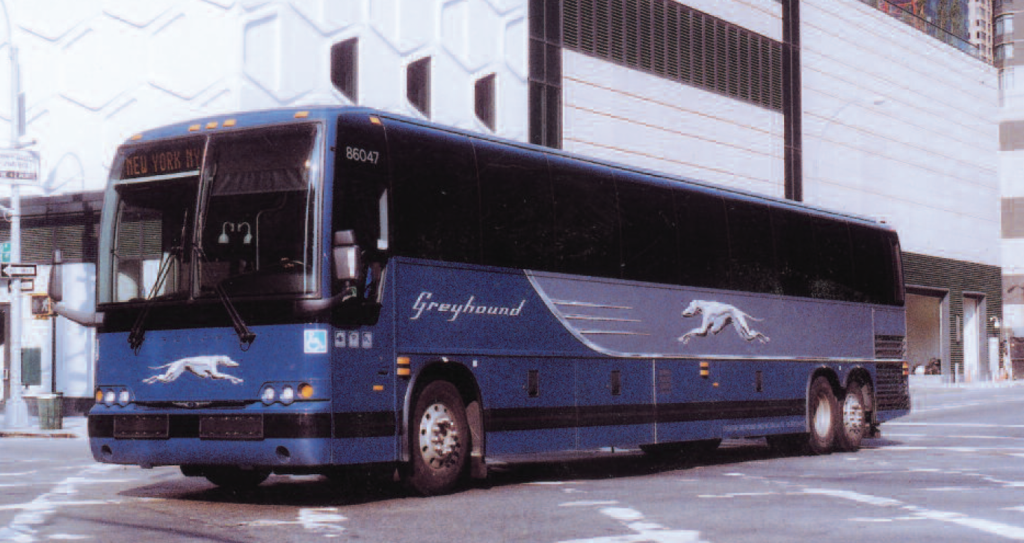
Eventually, the new design, technology and systems of the H series became available in additional models. Introduced early in 1990, the second model of the H series was the H3-40, offered as a high-quality charter and tour coach. It had a length of 40 feet, three axles with duals on the second axle, and all the design and technology of the H series. It quickly became a favorite coach for higher quality charter and tour service.
Prevost moved into the 45-foot length in stages. In 1993, Prevost offered the LeMirage XL in two different conversion shell configurations. A 45-foot motor home shell had a shorter wheelbase, a better turning radius but less underfloor space. A companion Entertainer version had a longer wheelbase and more underfloor space.
In January of 1994, Prevost introduced the third model in their H series as the H3-45. A conversion shell version became available in June of 1994 and became known as the VIP. In the following year, 1995, a commercial seated version of the LeMirage XL became available in the 45-foot length. At that same time, Prevost changed the previous H3-40 model to the new H3-41 model with a length of 41 feet to take advantage of Canadian regulations.
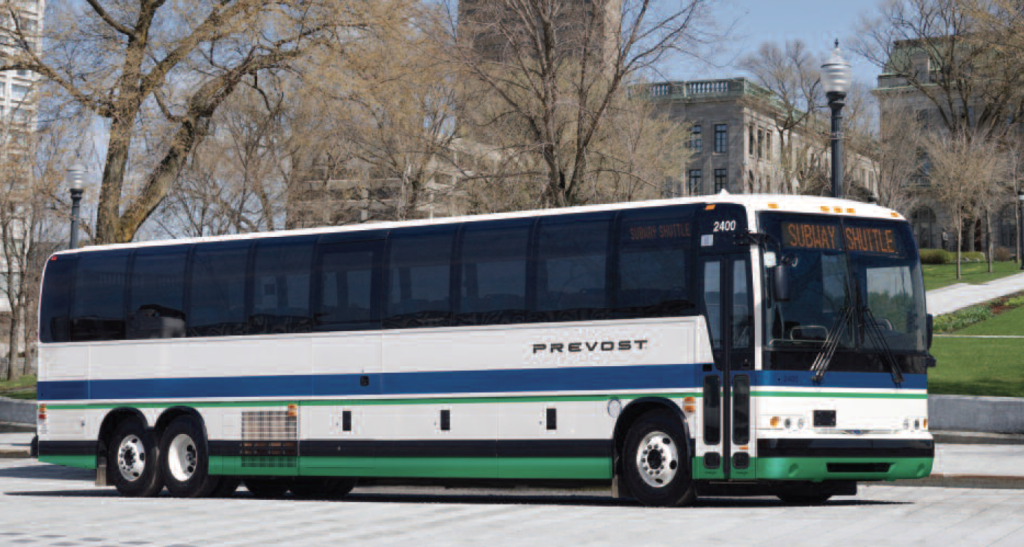
Volvo Steps In
Volvo Group from Sweden and Henly’s from the United Kingdom purchased Prevost from Normand, Harbison and Campbell in 1995. Following some financial difficulties, Henly’s dropped out and Volvo assumed total ownership of Prevost in 2004. Since then Prevost has had the support of the big Volvo organization that has fostered improvements, offered state-of-the-art systems and both the Volvo engine and model improvements.
Noteworthy achievements in this period include the introduction of frameless windows in 1997, improving both appearance and passenger viewing. In 2002, Prevost introduced an exclusive and interchangeable wheelchair lift that could be installed on any lift-ready Prevost. The lift could be easily installed as needed but otherwise left out to increase luggage capacity. In 2005, Prevost introduced a new multiplex system that led the way to other system developments.
The traditional Prevost LeMirage model went through some extensive improvements at this time. It became known as the XL in 1984 when it was improved and widened to the new 102-inch width. A facelift in 2000 along with major improvements including more stainless steel resulted in a renaming to the XL II.
Another series of improvements came in 2006 and were introduced at the United Motorcoach Association (UMA) Motorcoach Expo in January in Tampa. In keeping with the same model numbering scheme as the H3-41 and H3-45, this new model was called the X3-45. Features included Prevost’s Independent Suspension System (ISS), an improved air conditioning system and a longer wheelbase with increased underfloor storage area.
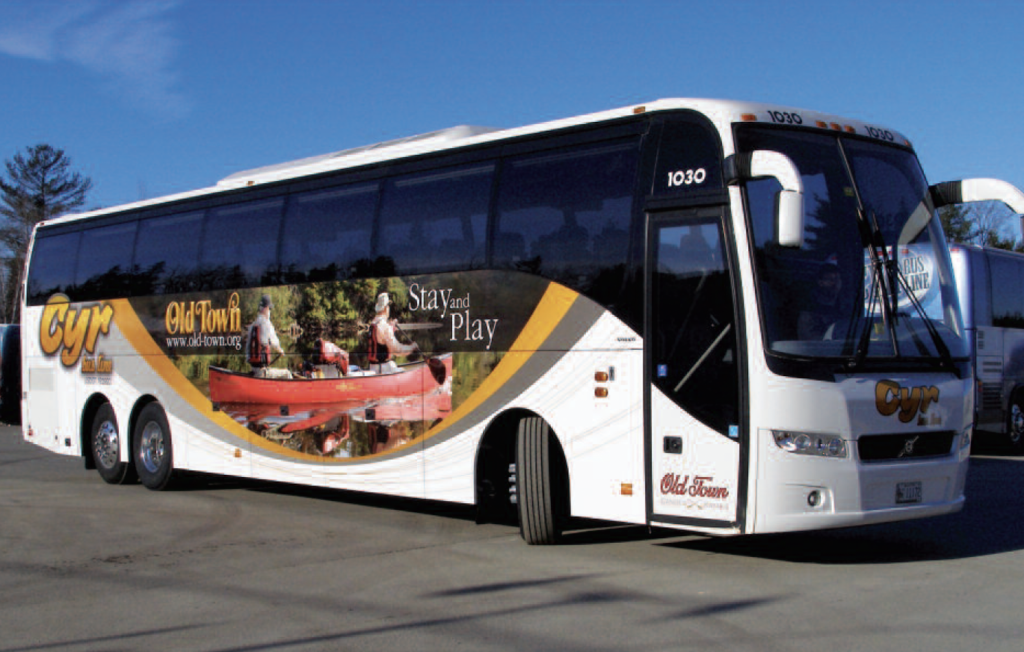
In 2010, Prevost introduced a Commuter Coach version of the X3-45 at the UMA Motorcoach Expo in Las Vegas. The first major contract came from MTA New York City Transit.
Depending on how you define it, the LeMirage, XL, XL II and X3-45 series has been called the longest running model in the coach industry by many. Granted, both the size and systems have changed over the years, but common threads run from one version to the next.
Prevost’s H3-41 and H3-45 models have also had major improvements in recent years. In 2002, a major facelift for the H-series models was introduced at the UMA Motorcoach Expo held in Indianapolis. Another round of improvements for the H-series coaches came in 2009 and was introduced at the UMA Motorcoach Expo in Orlando. The H3-45 has been the most popular high-tech charter and tour coach on the market for several years.
Prevost began offering the Volvo D13 engine in 2008. Originally offered as an EGR (Exhaust Gas Recirculation) engine, it became an SCR (Selective Catalytic Reduction) engine with the 2010 Environmental Protection Agency regulations. The Volvo I-Shift automatic stick shift also became available as an alternative to a powershift transmission.
Volvo’s 9700 model is the newest addition to the Prevost product line. Originally introduced by Volvo in Europe in 2001, the 9700 became immediately popular as a charter and tour coach. A Mexican version of the 9700 went into production at Volvo’s plant near Mexico City in 2002. Volvo developed a new 9700 model for the American market that was introduced at the UMA Motorcoach Expo in Orlando in January of 2009. It comes with a Volvo D13 engine and I-Shift and is sold and supported by Prevost.
The Prevost anniversary story will continue on with Part II in a future issue of National Bus Trader magazine. It will start where we left off and continue on to current developments and achievements.




